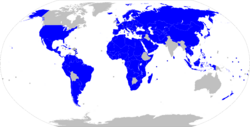Bureau International des Expositions facts for kids
 |
|

Head office at 34 avenue d'Iéna (16th arrondissement, Paris).
|
|

Member states as of May 2022
|
|
| Formation | 22 November 1928 |
|---|---|
| Type | International exhibitions |
| Headquarters | Paris, France |
|
Membership
|
184 members |
| Alain Berger | |
|
Secretary General
|
Dimitri S. Kerkentzes |
The Bureau International des Expositions (BIE), also known as the International Exhibitions Bureau, is an important international group. It was created to help organize and oversee huge international shows called Expos or World Expos. These Expos are big events where countries show off their ideas, inventions, and cultures to the world.
Contents
What is the BIE and Why Was It Created?
The BIE was started in Paris, France, on November 22, 1928. Its main goals are:
- To manage the schedule for World Expos, including choosing where they will be held.
- To make sure that everyone involved in an Expo, from the organizers to the countries participating, works together smoothly.
Today, 184 countries are members of the BIE. They all agree to follow the rules set by the BIE for these big international events.
The BIE helps organize two main types of Expos:
- World Expos (also called Registered Exhibitions)
- Specialized Expos (also called Recognized Exhibitions)
The BIE also recognizes special gardening shows called Horticultural Exhibitions and the Milan Triennial Exhibition, which focuses on art and design.
Types of Expos
Over the years, the rules for Expos have changed a bit, but they always divide them into World Expos and Specialized Expos. These rules decide how long an Expo can last, how often it can happen, how big it can be, and how buildings are constructed.
World Expos
World Expos are the biggest and most famous type of international exhibition. They happen about every five years and can last for up to six months.
- Big Ideas: World Expos focus on big challenges facing humanity, like "Man and His World" or "Age of Discoveries."
- Country Pavilions: Countries, international groups, and companies can build their own unique buildings, called pavilions, to showcase their ideas. These pavilions can be very large, sometimes like small city blocks!
- Huge Scale: These Expos cover massive areas, sometimes hundreds of football fields in size. For example, Expo 2010 in Shanghai was 528 hectares (that's over 1,300 acres!).
- Many Visitors: Millions of people visit World Expos. Expo 2010 in Shanghai had 70 million visitors!
- Transportation: Because they are so big, World Expos need lots of transportation like cable cars, monorails, and buses to help visitors get around.
Specialized Expos
Specialized Expos are smaller than World Expos and happen more often, usually between the big World Expos. They last for a shorter time, between three weeks and three months.
- Focused Themes: Unlike World Expos, Specialized Expos have a very specific theme. For example, "Future Energy" (Expo 2017 Astana) or "Living Oceans and the Coast" (Expo 2012 Yeosu).
- Shared Pavilions: Instead of building their own huge pavilions, countries usually use buildings provided by the Expo organizers. They then decorate and customize the inside.
- Smaller Size: The entire Expo site for a Specialized Expo is much smaller, usually no more than 25 hectares (about 60 acres). This makes them less expensive to host.
Before 1996, the difference between World and Specialized Expos was sometimes a bit blurry. Some Specialized Expos, like Expo 86 in Vancouver, were very popular and had many visitors, almost like a World Expo!
Member Countries
The BIE has 184 member countries from all over the world. These countries work together to make sure international exhibitions are successful and fair.
 Albania
Albania Algeria
Algeria Andorra
Andorra Angola
Angola Antigua and Barbuda
Antigua and Barbuda Argentina
Argentina Armenia
Armenia Austria
Austria Azerbaijan
Azerbaijan Bahamas
Bahamas Bahrain
Bahrain Bangladesh
Bangladesh Barbados
Barbados Belarus
Belarus Belgium
Belgium Belize
Belize Benin
Benin Bosnia and Herzegovina
Bosnia and Herzegovina Brazil
Brazil Bulgaria
Bulgaria Burkina Faso
Burkina Faso Burundi
Burundi Cambodia
Cambodia Cameroon
Cameroon Central African Republic
Central African Republic Chad
Chad Chile
Chile China
China Colombia
Colombia Comoros
Comoros Republic of the Congo
Republic of the Congo Democratic Republic of the Congo
Democratic Republic of the Congo Costa Rica
Costa Rica Croatia
Croatia Cuba
Cuba Cyprus
Cyprus Czech Republic
Czech Republic Denmark
Denmark Djibouti
Djibouti Dominica
Dominica Dominican Republic
Dominican Republic Ecuador
Ecuador Egypt
Egypt El Salvador
El Salvador Equatorial Guinea
Equatorial Guinea Eritrea
Eritrea Estonia
Estonia Fiji
Fiji Finland
Finland France
France Gabon
Gabon Gambia
Gambia Georgia
Georgia Germany
Germany Ghana
Ghana Greece
Greece Grenada
Grenada Guatemala
Guatemala Guinea
Guinea Guinea-Bissau
Guinea-Bissau Guyana
Guyana Haiti
Haiti Honduras
Honduras Hungary
Hungary Iceland
Iceland Indonesia
Indonesia Iran
Iran Israel
Israel Italy
Italy Côte d'Ivoire
Côte d'Ivoire Japan
Japan Jordan
Jordan Kazakhstan
Kazakhstan Kenya
Kenya Kosovo
Kosovo Kiribati
Kiribati North Korea
North Korea South Korea
South Korea Kuwait
Kuwait Kyrgyzstan
Kyrgyzstan Laos
Laos Lebanon
Lebanon Lesotho
Lesotho Liberia
Liberia Libya
Libya Lithuania
Lithuania Madagascar
Madagascar Malawi
Malawi Malaysia
Malaysia Maldives
Maldives Mali
Mali Malta
Malta Marshall Islands
Marshall Islands Mauritania
Mauritania Mauritius
Mauritius Mexico
Mexico Monaco
Monaco Mongolia
Mongolia Montenegro
Montenegro Morocco
Morocco Mozambique
Mozambique Namibia
Namibia Nauru
Nauru Nepal
Nepal Netherlands
Netherlands New Zealand
New Zealand Nicaragua
Nicaragua Niger
Niger Nigeria
Nigeria Norway
Norway Oman
Oman Pakistan
Pakistan Palau
Palau Panama
Panama Paraguay
Paraguay Peru
Peru Philippines
Philippines Poland
Poland Portugal
Portugal Qatar
Qatar Romania
Romania Russia
Russia Rwanda
Rwanda San Marino
San Marino Saint Kitts and Nevis
Saint Kitts and Nevis Saint Lucia
Saint Lucia Saint Vincent and the Grenadines
Saint Vincent and the Grenadines Samoa
Samoa Saudi Arabia
Saudi Arabia Senegal
Senegal Serbia
Serbia Seychelles
Seychelles Sierra Leone
Sierra Leone Slovakia
Slovakia Slovenia
Slovenia Solomon Islands
Solomon Islands South Africa
South Africa Spain
Spain Somalia
Somalia Sri Lanka
Sri Lanka Sudan
Sudan South Sudan
South Sudan Suriname
Suriname Swaziland
Swaziland Sweden
Sweden Switzerland
Switzerland Syria
Syria Tajikistan
Tajikistan Tanzania
Tanzania Thailand
Thailand Timor-Leste
Timor-Leste Togo
Togo Tonga
Tonga Tunisia
Tunisia Turkey
Turkey Turkmenistan
Turkmenistan Tuvalu
Tuvalu Uganda
Uganda Ukraine
Ukraine United Arab Emirates
United Arab Emirates United Kingdom
United Kingdom United States
United States Uruguay
Uruguay Uzbekistan
Uzbekistan Vanuatu
Vanuatu Venezuela
Venezuela Vietnam
Vietnam Yemen
Yemen Zambia
Zambia Zimbabwe
Zimbabwe
Countries That Have Left or Rejoined
Some countries have changed their membership status with the BIE over time.
Australia
Australia used to be a member and even hosted the World Expo 88. However, in 2015, they decided to leave the BIE.
Canada
Canada also ended its membership in the BIE in 2012.
United States
The United States was not a member of the BIE from 2001 to 2017. During this time, it was harder for cities in the U.S. to host BIE-approved Expos. However, the U.S. rejoined the organization on May 10, 2017.
Fun Facts About Expos
Expo Mascots
Since 1984, Expos have had fun fictional characters called mascots. These mascots are designed to represent the host city or the Expo's theme. For example, Seymore D. Fair was the mascot for the 1984 Louisiana World Exposition. Other famous mascots include Curro from Seville Expo '92 and Haibao from Expo 2010 in Shanghai.
BIE Anthem
The official song, or anthem, of the Bureau International des Expositions is a part of Dvořák's famous Symphony No. 9 in E Minor "From the New World".
See also
- List of world expositions – A list of all the Expos officially recognized by the BIE.
- List of world's fairs – A broader list that includes other large fairs, not just those approved by the BIE.

